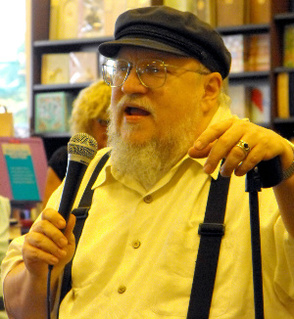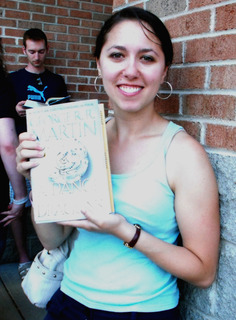
Best-selling fantasy author George R.R. Martin. - Photo by Andrew Firestone
By Andrew Firestone
Somervilliens always seem to be on the right side of the literary tracks, but this last Tuesday, July 12, a few of them absconded to Burlington where best-selling fantasy author George R.R. Martin held court. Partly in celebration for the release-day of his fifth book in the Song of Ice and Fire series, A Dance with Dragons, and partly due to his ever-rising fame from the HBO television adaptation, Game of Thrones, these lucky ‘Villens joined over 1,000 fans outside the Barnes and Noble booksellers to meet the famous author and come away with a signed copy of his book.
A Song of Ice and Fire takes place in a medieval-style fantasy world, complete with all the classic staples of Tolkien; magic, dragons, damsels and heroes all vie for survival in the fictional world of Westeros. What separates the series from its contemporaries is not only the labyrinthine depth of the stories (each book features a host of POV characters, and are at least 800 pages long in paperback), but the cohesiveness of the massive literary field of characters and realpolitik with which they interact in each of the many story-lines at play.
“I think that it’s adult science fiction and it’s good way to escape the day,” said ‘Villen Lea Lupkin who read through the thousands of pages in the first four books and waited for six hours in the 90 degree heat. Lupkin said that these complexities involved in the series’ shining knights and grinning villains make the books intriguing.
“I think that’s part of what makes the story so different and interesting and keeps you engaged constantly because you think you know a character and then it switches it up,” she said.
Her friend Waylon was quick to point out that Martin’s approach, in his opinion, was as much a part of a more realistic world for his books as a desire to upend common staples that have turned the much-loved fantasy genre into a litany of tired cliche.
“[Martin] disliked a lot of the way the hero character was inevitably successful,” he said. “It’s not that he takes archetypes and uses them differently, or even tries to de-construct the archetype, he just adds the realistic effect that sometimes the [ethical] leap [of faith] goes wrong for people.”
Martin said that this ongoing discussion in his literature is tied to the dichotomy of any conflict, especially where moral truth is concerned. “I think one of the themes of the book is the examination of heroism,” said Martin. “I have always been fascinated with [the idea], the villain is the hero of the other side.The great fight in the Illiad between Achilles and Hector is in some ways my model more so than fights between a hero and villain traditionally are. What constitutes a hero? Is a hero always a hero?”
In Martin’s book, A Game of Thrones, he seems to set up a world where a hero, Ned Stark, arrives at the king’s side in order to meet a threat of a rival dynasty. In practice, however, Ned’s honor ends up causing more harm than good, and the chief villain, named Viserys, proves to be more sympathetic than menacing, said Lupkin. Waylon called this moral situation, which arises often in the books, “the anti-trope.”
“I have read a lot of fantasy,” said Martin. “In some sense all of fiction is an ongoing discussion between the authors where we’re responding to each other’s viewpoints and giving our take on it.”
“Some of these familiar tropes and archetypes of fantasy have been with us for a long time and there’s value in them. I don’t think I’m necessarily throwing [them] away as much as I’m looking at them and saying ‘yes but…’ But there’s another side to that. But it’s not as simple as that. Try looking at it from this way,” he said.
Martin noted the heavy influence that fairy tales have had on the fantasy genre, and said that he honored their tradition, despite the often dark matter of his novels.
“Actual fairy tales, the original fairy tales, are very dark,” he said. “There’s a tremendous amount of darkness in the Brothers Grimm and Hans Christian Anderson and people like that. Our view of fairy tales is unfortunately colored by Disney.” He noted that in the original tale, The Little Mermaid, the titular Ariel could only walk with intense pain shooting through her legs.
“Our fairy tales have been softened and pre-digested for modern audiences and particularly children to make them safe and harmless,” said Martin, “but the original fairy tales are some dark stuff. So maybe my stories are much more like the original fairy tales than in Disney’s version.”
Martin has faced criticism from throngs of devoted readers and television audience members, who grow frustrated when their favorite character is put on the chopping block, literally and shockingly without reprieve. “When your favorite character is in a dangerous situation, you should be afraid to turn the next page,” he said of his technique, “just as that character might be afraid to go out to fight in the battle because I think that’s how people feel in these situations.”
Martin stayed until the wee hours signing books for all who made it out. A Dance with Dragons sold over 298,000 copies that day, the record for any book published in 2011. He will also be writing an episode for season two of Game of Thrones depicting an epic naval battle.


















Reader Comments